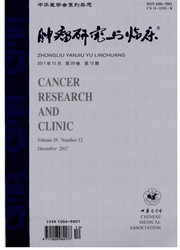

 中文摘要:
中文摘要:
目的 建立肝癌肿瘤相关成纤维细胞(CAF)分离、培养体系,并予以鉴定,同时进一步探讨CAF对肝癌细胞生物学功能的影响.方法 肝细胞癌(HCC)术后患者的肿瘤组织通过胶原酶消化、离心、重悬等技术手段,分离、纯化CAF.分别通过形态学观察及免疫荧光技术对CAF进行鉴定.在此基础上将分离鉴定的CAF与肝癌细胞株Huh7、HepG2进行共培养,建立CAF与肝癌细胞株体外共培养系统,同时利用CCK-8实验观察CAF对Huh7、HepG2细胞增殖的影响;利用Transwell实验分析CAF对Huh7、HepG2细胞侵袭能力的影响.结果 分离、培养成功的CAF形态学表现为长梭状或纺锤状,细胞体积与细胞核较其他细胞明显偏大.免疫荧光结果显示CAF特殊标志物α平滑肌肌动蛋白(α-SMA)和纤维连接蛋白均呈强阳性,并主要表现为胞膜染色.而肝癌细胞表面的特殊标志物甲胎蛋白(AFP)及血管内皮细胞表面特殊标志物CD31均阴性.Huh7、HepG2的增殖和侵袭能力明显增强.其中CAF与Huh7和HepG2细胞共培养24 h后,空白组与实验组中的细胞增殖率分别为(63±4)%、(78±5)%和(69±5)%、(81±3)%,差异均有统计学意义(均P〈0.05).CAF增强Huh7和HepG2穿膜能力,空白组与实验组中的穿膜细胞数目分别为(59.4±3.1)、(162.9±3.9)个和(104.8±2.6)、(166.4±4.2)个,差异均有统计学意义(均P〈0.05).结论 HCC患者肿瘤组织中分离、培养的细胞为CAF.CAF形态结构及蛋白表达等具有特异性,并促进肝癌细胞的增殖和侵袭.
 英文摘要:
英文摘要:
Objective To establish an in vitro isolation and culture system for hepatocellular carcinoma (HCC)-associated fibroblast (CAF) and identify based on its specific markers of CAF. Methods CAF was isolated from the tumor tissue of the HCC patients after hepatectomy, by digesting with collagenase enzyme, centrifugation and resuspension. The morphology of CAF was observed by electron microscopy. Immunofluorescence staining was performed for detecting α-SMA and fibronectin as well as other specific markers such as AFP on the surface of HCC cells and CD31 on the surface of vascular endothelial cells. On the basis of the study, the function work between CAF and HCC cell line Huh7, HepG2 was detected under co-culture system. Meanwhile, CCK-8 was used to observe the effect of CAF on the proliferation of Huh7 and HepG2 cells, and Transwell assay was used to analyze CAF effect on the invasion of Huh7 and HepG2 cells. Results Compared with the other cells, the morphological analysis showed that CAF was more elongated or spindle-shaped. Moreover, the cell size and the nucleus were larger than normal epithelial cells. Immunofluorescence staining revealed that the CAF surface specific markers including α-SMA and fibronectin were positive, and mainly were the cell membrane staining. The proliferation and invasion of Huh7 and HepG2 were significantly increased by CAF. The results show that the increasing percentage of cells in 24 hours between blank group and the experimental group was (63 ±4) %, (78 ± 5) % and (69 ± 5) %, (81 ± 3) %respectively after co-culture with CAF, the difference was statistically significant (P〈0.05). In transwell model, the number of cells in the blank group and the experimental group was (59.4 ± 3.1), (162.9 ± 3.9) and (104.8 ± 2.6), (166.4 ± 4.2), and the difference was also statistically significant (P〈0.05). Conclusion The isolated CAF from HCC enhances the ability of tumor's proliferation and invasion.
 同期刊论文项目
同期刊论文项目
 同项目期刊论文
同项目期刊论文
 期刊信息
期刊信息
